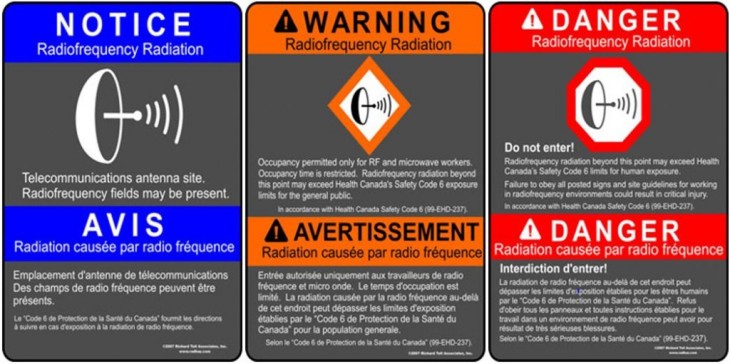With the Canadian government on summer vacation and a fall election looming, it will be up to the next wave of politicians to respond to calls for action on radiation risks associated with the use of cellphones, smartphones and other wireless devices.
The fact that the government itself has made such a call would seem to indicate a readiness for action that many have long advocated and tried to build.

Some warning signs and labels with information about wireless radiation risks and Canada’s Safety Code 6.
Just last month, Canada’s Standing Committee on Health unanimously adopted the final report into their study of Health Canada’s Safety Code 6, which sets out guidelines and limits for human exposure to radiofrequency electromagnetic energy.
The ten MP member panel had heard from many involved with the wireless radiation issue, including leading scientists and doctors from Health Canada, the Canadian Wireless Telecommunications Association and elsewhere.
The Code, first written in 1999, had not been updated since. For the past two years at least, organizations had been reviewing the Code with a view to recommending updates, but members of those organizations were seen to be in a conflict of interest, having worked or consulted previously with industry.
The Canadian Medical Association Journal, for example, has published scathing condemnations of Health Canada’s safety guidelines for cellphones and Wi-Fi.
The Journal (CMAJ) reported on interviews with multiple international experts in radiation and cancer itself, noting that they warn how the microwave levels allowed in Canadian classrooms, residences and workplaces are “a disaster to public health.”
The Journal article also pointed out that the Committee itself had to ask federal representatives to ‘go back to work’ and review some 140 recent studies that show wireless radiation emitted by cellphones and Wi-Fi can cause harm. It cited one scientist who said that given the overwhelming evidence that wireless radiation is harmful, Health Canada is “unwilling or not competent to make evaluation of the current literature.”
The CMAJ also reported on conflicts in the review panel, and the article noted that James McNamee, a key contributor to Health Canada’s safety code, has also co-authored academic papers with scientists who openly accept payments from the wireless industry.
Then, barely a week after the Standing Committee on Health unanimously adopted the final report into their study of Health Canada’s Safety Code 6, the Committee Chair read and tabled a series of recommendations in the House of Commons calling call for action that in some ways cast doubt on the Code itself.
Ontario MP Ben Lobb (Conservative, Huron) noted some 15 recommendations calling for among other things, the current wireless exposure and radiation risk guidelines to be updated; further research to be conducted; and for funding to be available that would support new awareness campaigns so that cellphone and wireless device users are better informed about the potential risks associated with their use.
The (next) Government of Canada should, the recommendations say, examine existing cancer data collection methods to improve the collection of information relating to wireless device use and cancer.
It should, through the Canadian Institutes of Health Research, consider funding research into electromagnetic hypersensitivity testing, diagnosis and treatment, and its possible impacts on health in the workplace.
The Committee’s recommendations also call on other Canadian and international bodies to consider updating their guidelines and education materials regarding the diagnosis and treatment of electromagnetic hypersensitivity, mentioning the Canadian Medical Association, the Royal College of Physicians and Surgeons, the College of Family Physicians of Canada and the World Health Organization.
Perhaps most interestingly, the Committee wants the government to “develop an awareness campaign relating to the safe use of wireless technologies, such as cellphones and Wi-Fi, in key environments such as the school and the home to ensure that Canadian families and children are reducing risks related to radiofrequency exposure.”
On its website, Health Canada says Canadians can take practical measures to reduce their RF exposure by:
– limiting the length of cellphone calls;
– using hands-free devices;
– texting instead of calling.
But those rather basic warnings and awareness efforts pale in comparison, for example, with the money being spent to warn Canadians about the dangers of marijuana (TV ads running now will continue into August), said to be more than $7 million.
That’s more money than Health Canada spent advertising all its programs and services combined in the previous 2013-14 fiscal year, reports indicate.
While comparing and contrasting apparent risk factors between the two activities could be a mug’s game, assessing the effective per capita cost of reaching the two demographic categories is much easier.
In 2013, 83 per cent of Canadian households had an active cellphone (with no word on how often or how recently they had used it). The reported number of Canadian wireless phone subscribers is more than 28.4 million.
In 2012, 39 per cent of Canadians reported having used marijuana at least once in their lifetime (with no word on how many or few had it in their household). The admitted number of Canadian marijuana users is just over 10 million.
Interestingly, the Canadian Medical Association was one of the Canadian health care sector organizations that issued a release last August saying they would not endorse the government ads about marijuana. That announcement came shortly after the CMA’s Journal called the government wireless radiation policy “a disaster to public health.”
-30-




Good of you to draw attention to all this. But the HESA committee’s recommendations are lamer than lame considering all the evidence, even what was before them. Back in 2010 the same committee due especially to political machinations after hearing similar evidence did less still. 5 years along more suffering and death, politicoes ultimately beholden to the real if indirect controllers of “Health” Canada. Back in 2010 9 of 10 “expert” witnesses for the status dangerous quo were industry-connected.
Anyway it’s time to focus on local and provincial health “authorities”, while indirectly corruptible as well by the system of putting industry-financial-&c health ahead of the public’s, are within closer reach, and jurisdictionally, health ultimately is NOT federal. Provinces can take independent action.